|
|
||||
|
Published by : PROFESSIONAL MEDICAL PUBLICATIONS |
||||
|
ISSN 1681-715X |
||||
|
||||
|
- |
||||
|
ORIGINAL ARTICLE |
||||
|
- |
||||
|
Volume 25 |
April - June 2009 (Part-II) |
Number 3 |
||
|
|
||||
|
|
||||
|
|
||||
|
Published by : PROFESSIONAL MEDICAL PUBLICATIONS |
||||
|
ISSN 1681-715X |
||||
|
||||
|
- |
||||
|
ORIGINAL ARTICLE |
||||
|
- |
||||
|
Volume 25 |
April - June 2009 (Part-II) |
Number 3 |
||
|
|
||||
|
|
||||
Comparing the effect of firefighting protective
clothes and usual work clothes during
physical activity on heat strain
Majid Najafi Kalyani1, Nahid Jamshidi2
ABSTRACT
Objective: Firefighters must use protective clothing to avoid physical, chemical and environmental damages in their works. Firefighting clothing should cause the minimal physiological, mental and organic limitations on the body, beside their protective features. The aim of this study was to compare the firefighting protective clothing and usual work clothing, in terms of their effects on heat strain during physical activity.
Methodology: This is a cross-over study, in which 30 young male were recruited according to inclusion criteria. After choosing the participants, the physical activity was done once by wearing Firefighting protective clothing and again by wearing usual work clothing by random, based on Bruce exercise protocol. Before and after the physical activity, parameters such as Heart rate and Core temperature were measured. The Physiological Strain Index (PSI) was calculated by setting core temperature and heart rate according to Moran’s equation.
Results: The results show that the Physiological Strain Index (PSI) was 6.15±1.12 in participants with firefighting protective clothing, while this number was 3.64±0.81 for usual work clothing. This difference is statistically significant (p<0.001). These two sets of clothes are different in their effects on Parameters such as Heart Rate, Core temperature and PSI. The obtained values for usual work clothing are better than firefighting protective clothing.
Conclusions: Firefighting protective clothing causes higher level of heat stress and lower tolerance time, because the Physiological Strain Index (PSI) and Core temperature for these clothing was observed higher than the usual work clothing. Heat stress resulted in elevated core temperature which reduce tolerance of firefighters and in severe cases cause risk of heat stress.
KEY WORDS:
Physiological strain index, Protective clothing, Heat stress, Core temperature.Pak J Med Sci April - June 2009 (Part-II) Vol. 25 No. 3 375-379
How to cite this article:
Kalyani MN, Jamshidi N. Comparing the effect of firefighting protective clothes and usual work clothes during physical activity on heat strain. Pak J Med Sci 2009;25(3): 375-379.
1. Majid Najafi Kalyani,
Lecturer, MSN, Ph.D student.
Depat. of Medical Surgical Nursing, School of Nursing,
Fasa University of Medical Sciences, Fasa, Iran .
(School of Nursing, Shiraz University of Medical Sciences,
Shiraz, Iran).
2. Nahid Jamshidi, BSN, MS student.
Razi Nursing School, Kerman Medical Sciences University,
Kerman, Iran.
Correspondence
Majid Najafi Kalyani,
E-mail: majidnajafi5@yahoo.com
* Received for Publication: January 27, 2009
* Accepted: May 12, 2009
INTRODUCTION
In many jobs individual are required to use protective clothing to prevent adverse exposure to physical, chemical and environmental stress factors. Firefighters must use protective clothing and it is a requirement for the safety of firefighters, because this protective clothing offers enough protection.
1 The Center of disease control reported 6864 deaths because of high temperature in working condition from 1966 to 1979.2 The increasing use of heavy and impenetrable clothes at work discloses the harmful effects of temperature on body. In 1994, the army air force of the U.S. declared that 19 forces men have been hospitalized due to their exposure to heat while doing the activity. At this year, the army hospitalized 196 people because of heat stress and the resulting diseases.3 While firefighter wears protective clothing, reduction of heat stress is of primary importance.4 When firefighters must work in protective clothing in warm environment, the inherent features of this protective clothing typically interferes with work performance.5 Work in this situation and consequent heat stress resulted in elevated core temperature which reduce tolerance of firefighters and in severe cases cause risk of heat stress.5 However, firefighting protective clothing seriously reduces worker productivity and minimal guidelines are available to firefighters.5During the last decade the interest in research on protective clothing and their effects has grown. In critical situations, like fire, a person has to use protective clothing during physical activity. So, it is necessary to minimize the risk of heat stress. Monitoring of heat stress during activity is especially important for firefighters that wear protective clothing while working in the heat.
6 To improve risk for firefighters who perform in the heat, both environmental heat stress and physiological heat strain are important. In order to monitor the physiological strain, physiological variable must be considered.6 Moran et al. developed physiological strain index (PSI) that places the heat strain on a scale of 0-10. This index standardizes the interpretation of the heat stress for individuals and work environment. The physiological strain index (PSI) was calculated according to Moran et al.6-8The purpose of this study was to see the effect of firefighting protective clothing on physiological strain index with emphasis on their effects on heat stress and work performance.
METHODOLOGY
This was a cross-over study. Sampling method was according to purpose and based on inclusion criteria. Thirty young men participated in this study. Their selection criteria were good general health, according to health status check list, no heart disease, no respiratory, renal, anemia and no diabetic history, and without any professional athletic history. They had no history of any injury, and negative smoking history. They were 18 to 25 years old and within the determined range of body mass index (19.2 – 29.2). Each individual completed the exercise protocol on treadmill (model TF 9990) by wearing randomly firefighting protective clothing and usual work clothing with interval of at least 48hours.
9,10The study conditions included two room equipped with required laboratorial instruments. The primary parameters such as heart rate (S&W machinery model temp 8680) and Core temperature (microlife machinery) were measured. After measurement of core temperature via tympanic membrane and heart rate individuals wore clothing and started exercise protocol. First, participant walked slowly by the speed of 2.74 km/h and 10 degree slope for warm up. After every three minutes, speed and slope of treadmill increased according to Table-I.
11
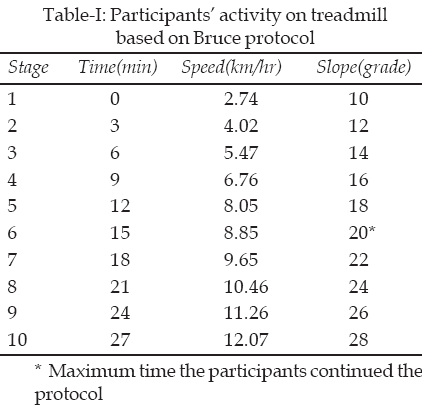
The criterion for stopping the test was the participant’s fatigue or increasing his heart rate beyond the expected maximum or core temperature more than 39.5°C.6,12 The exercise protocol in this study was Bruce protocol.12 During physical activity heart rate and core temperature were measured and recorded. The physiological strain index (PSI) was calculated according to Moran et al.6-8 The equation used was:
PSI= (5 x (Tri-Tr0)/ ((39.5-Tr0)) +
(5 x (HRi-HR0) x (180-HR0))
In this Tri and HRi are measurements taken at any time during the activity; and Tr0 and HR0 are the seated resting values prior to beginning the exercise protocol. The PSI consists of values between one and ten when values for HR fall between 60-180 and Tr between 36.5 – 39.5°C.
7,8Data were analyzed by SPSS (version 15). The results reported as standard deviation ± mean (SD±Mean). To compare the means of PSI in two clothes, paired sample t-test was used. To investigate the relationship between PSI and the core temperature, Pearson’s coefficient was used.
RESULTS
Characteristics of participants are shown in Table-II. According to these result, the range of age was 21.6±1.4 and mean was 22.44±2.24 BMI. Means of height and weight used in BMI calculating were respectively 173.90±4.4cm and 67.72±5.93kg.
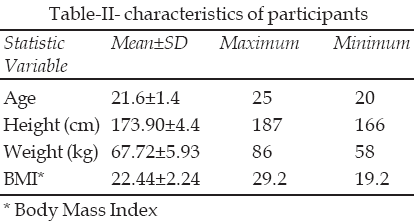
To investigate the participant’s physiological and homodynamic changes, the core temperature of body, heart rate, respiratory rate and blood pressure were measured. Before the test it did not show any statistically significant relation in both sets of Clothes (p>0.05). The results of this study show that physiological strain index (PSI) in usual work clothes was 3.64±0.81 and in fire-fighting protective clothes was 6.15±1.12, so that this difference is statistically significant (p<0.001) Fig-1.
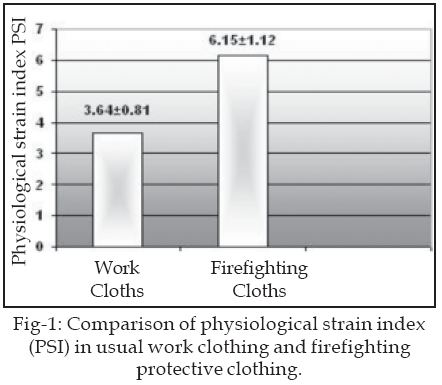
Core temperature of the participants during physical activity in usual work clothes was 37.9±0.39°C and in fire-fighting protective clothes 38.6±0.8°C, which was statistically significant (p<0.001) Fig-2.
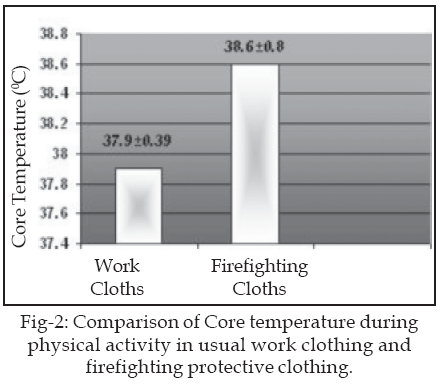
Heart rate of the participants during physical activity in usual work clothes was 128.1±10.6 beat/minutes and in fire-fighting protective clothes 134.8±16.8 beat/minutes, which was statistically significant (p<0.001) Fig-3.
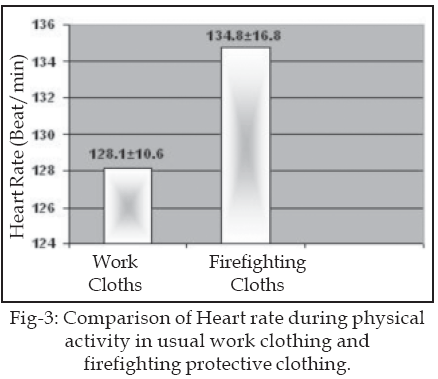
DISCUSSION
Heat stress is the composition of environmental and physical work factors that constitute the heat strain on individual while working.
6 Heat stress is the physiological response to the heat.6 Physiological strain index (PSI) based on core temperature and heart rate, capable of indicating heat strain developed for calculating heat strain.7 In this study, Physiological strain index (PSI) in the group using firefighting protective clothing was significantly higher than the group with usual work clothing. In practical terms it means that, the persons are likely to risk getting heat-induced disorders such as heat cramps, heat exhaustion and heat stroke.6 Some researchers did not introduce any specific physiological parameters on fatigue span while doing activity, and stated various physiological and psychological factors.13,14
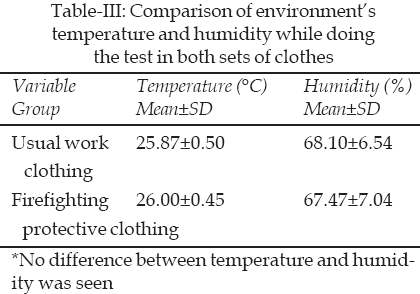
Heat storage in body and core temperature increase due to decrease in heat dissipation cause earlier fatigue and increase in physiological strain index.
14,15 The significant increase in the body temperature of the group with protective clothing in comparison with the other group shows early fatigue, although weight of protective clothing can be the cause of earlier fatigue due to physical features and potential collection of sweat.14 Weight of protective clothes is an important factor in cardio-pulmonary damages.16 Moreover, core temperature, perspiration and dehydration increase. Therefore, blood pressure decrease and osmolarity increases, and causes peripheral blood flow and inspiration to decrease and all these lead to high temperature and decrease tolerance time14,15 Rissanen et al has showed that protective clothing can cause higher body heat storage and faster rewarming during physical activity.16 These findings are similar with our study. Mcllelan et al in a study repots that replacing pants with shorts under the firefighting protective clothing reduced the heat stress associated with wearing the protective clothing.17 Higher level of PSI in firefighting protective clothing can cause lowering of firefighter productivity is lowered by heat stress and fatigue.6,16,17 Goldman has showed that tolerance time of protective clothes decrease by increasing environmental temperature.18The result of this study show that activity time in usual work clothing is significantly more than firefighting protective clothing. In a study by Ghasemi et al, the same results have been obtained for fatigue time of military and chemical protective clothes.
10 Intensity and time of activity can also affect tolerance of people, so it is suggested that people using protective clothing do their activities slowly to increase their activity time. Aoyagi showed that the distance by usual work clothing is more than protective clothing.19 He concluded that wearing protective clothing in hot environments increase perspiration and cause decrease in blood volume and tolerance time.19 The results of other studies show that suggesting a general guideline for protective clothing is difficult because of high difference in protective clothing and also different participants.6,14,18,19In summary the results showed that firefighting protective clothing have weaker results in cases such as activity time, distance, and fatigue time. Based on the obtained results, it is suggested that heads and workers of fire stations do not force using firefighting protective clothing and allow the same usual work clothing for a specific time to improve the physical capacity of individuals. It is also suggested to make all assistants familiar with these clothes limitations to avoid early fatigue and heat strain. Compatibility of individuals with these clothing in daily training can increase their ability in using these clothing and minimize heat stress by decreasing PSI. The ease of calculation and scaling of the PSI make it applicable as a monitor of heat stress of physical activity during work conditions. Monitoring of heat stress during activity is especially important for firefighters who wear protective clothing while working in the heat.
Limitations of the study: Environment’s heat and humidity effects that were controlled by choosing the same time span and a laboratory environment which had a relatively constant humidity. The parameter of body’s ability as a limitation was also controlled by comparing the individual’s participation in both groups and the criterion of not having professional sport history and body mass index for the whole group in the range of 19.2 to 29.2.
REFERENCES
1. Holmer I. Protective clothing and heat stress. Ergonomics 1995;38(1):166-182.
2. Centers for Disease Control and Prevention. Heat related illness and death-missouri,1998 and United States 1979-1986. Morbid Mortal Weekly Rep 1999;48:469-473.
3. Gardner JW, Amoros PJ, Grayson JK. Hospitalization due to injury. Inpatient medical records data. Mili Med 1999;164,5.
4. Heled Y, Epsetin Y, Moran DS. Heat strain attenuation while wearing NBC clothing:dry-ice vest compared to water spray. Aviat Space Environ Med 2004;75(5):391-6.
5. Bishop P, Ray P, Reneav P. A review of the ergonomics of US military chemical protective clothing. Intern J Industrial Ergonomics 1995;15:271-83.
6. Gotshall RW, Dahl DJ, Marcus NJ. evaluation of a physiological strain index for use during intermittent exercise in the heat. J Exercise Physiology 2001;4(3):22-29.
7. Moran DS, Shitzer A, Pandolf KB. A physiological strain index to evaluate heat stress. Am J Physiol 1998;44:129-134.
8. Moran DS, Montain SJ, Pandolf KB. Evaluation of different levels of hydration using a new physiological strain index. Am J Physiol 1998;275:854-60.
9. Chenung SS, Mclellan TM, Tenaglia S. The thermophysiology of uncompensable heat stress. Sport Med 2000;2(5):329-59.
10. Ghasemi A, Asgari A, Farajzade A. Comparing the effect of Iranian and German chemical protective clothes on some physiological parameters of people. J Mil Med Spring 2005;(7):1-9.
11. MC Ardle WD, Katch FI, Katch VL. Exercise physiology. 5th edition. Lippincott Williams & Wilkins 2001;459-85.
12. Niavarani A, Medical physiology-Vol 1 – 10 ed, Samat publication. 2000;234-320.
13. Mclellan TM, Jacobs I, Brain JB. Influence of temperature and metabolic rate on work performance with Canadian force NBC clothing. Ergonomics 1993;64(7):587-94.
14. Kalyani MN, Ebadi A, Mehri SN, Jamshidi N. Comparing the effect of Fire-fighting protective clothes & usual work clothes on aerobic capacity (VO2max). Pak J Med Sci 2008;24(5):678-83.
15. Sawka MN, Latzka WA, Montain SJ, Cadarette BS, Kolka MA, Krning KK, et al. Physiological tolerance to uncompensable heat, intermittent exercise, field vesus laboratory. Med Sci Sport Exerc 2001;33(3):22-430.
16. Rissanen S, Rintamaki H. Thermal responses and physiological strain in men wearing impermeable and semi permeable protective clothing in the cold. Ergonomics 1997;40(2):141-50.
17. Mclellan TM, Selkirk GA. Heat stress while wearing long pants or short under firefighting protective clothing. Ergonomics 2004;15(1):75-90
18. Goldman RF. Tolerance time for work in the heat when wearing CBR protective clothing. Military Medicine1998;128(8):778-6.
19. Aoyagi Y, Mcellan TM, Shephard RD. Effects of training and acclimation on heat tolerance in exercising men wearing protective clothing. Eur J Appl Physiol Occup Physiol 1994;68(3):234-45.
HOME | SEARCH | CURRENT ISSUE | PAST ISSUES
Professional
Medical Publications
Room No. 522, 5th Floor, Panorama Centre
Building No. 2, P.O. Box 8766, Saddar, Karachi - Pakistan.
Phones : 5688791, 5689285 Fax : 5689860
pjms@pjms.com.pk